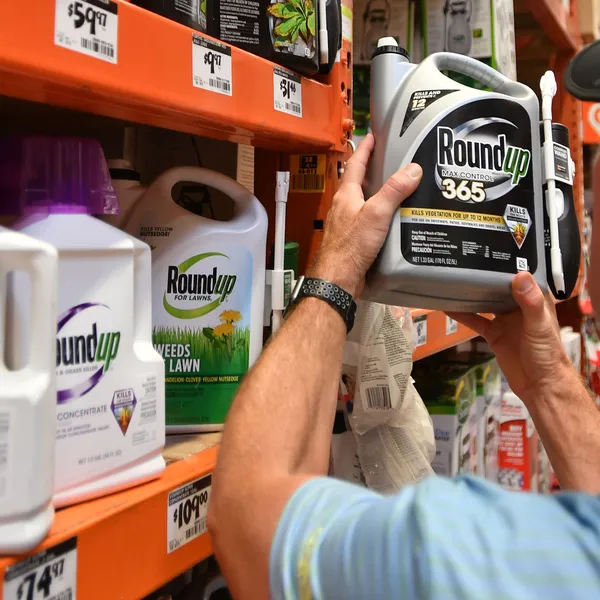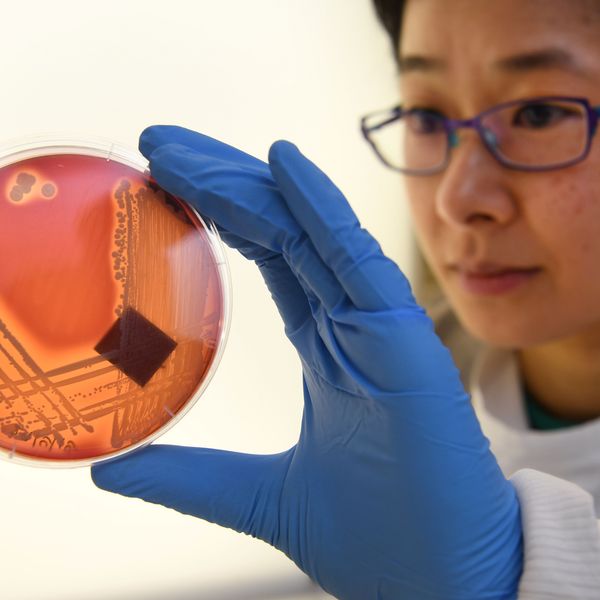A New Report Reveals that GM Seeds Encourage Pesticides Use, Contribute to Growth of Superweeds
A new report out today, Impacts of Genetically Engineered Crops on Pesticide Use in the United States: The First Thirteen Years [pdf] authored by Dr. Charles Benbrook, chief scientist at The Organic Center,
reveals that the use of genetically modified (GM) corn, soy and cotton
crops has increased the amount of pesticides used in the past 13 years
by 318 million pounds.
This information comes to light as the industry struggles to
position itself as providing environmental benefit through use of bt
technology - insecticide producing seeds - savings from which are
diminished in light of a six times greater herbicide usage.
Farmers have become increasingly critical of both GM seed as it goes
up in price, and herbicides like Roundup, also known as glyphosate, as 'superweeds'
become prevalent in treated fields. The growth of pigweed, which can
quickly reach widths of 6 inches at the stalk, and other invasive,
glyphosate-resistant species increases farmers reliance on more
high-risk herbicides, including 2,4-D, dicamba and paraquat, and has
resulted in a return to hand harvesting and even abandoning of fields.
Dr. Benbrook used the USDA's National Agriculture Statistics Service
data and publicly available Monsanto information to ascertain these
findings. The report states that it became increasingly difficult to
get such information from the USDA as it ceased collecting thorough
data on pesticide usage in the US in recent years. Furthermore, while
the USDA has never conducted research on the relationship between GM
crops and increased pesticide use, resulting in a lack of in-depth
information to inform regulators. (I wrote about the need for more such research here, where Dr. Benbrook also chimed in.)
The report challenges researchers and regulators to consider the following:
Herbicides and insecticides are potent environmental
toxins. Where GE crops cannot deliver meaningful reductions in reliance
on pesticides, policy makers need to look elsewhere. In addition to
toxic pollution, agriculture faces the twin challenges of climate
change and burgeoning world populations. The biotechnology industry's
current advertising campaigns promise to solve those problems, just as
the industry once promised to reduce the chemical footprint of
agriculture. Before we embrace GE crops as solution to these new
challenges, we need a sober, data-driven appraisal of its track record
on earlier pledges.
With glyphosate producer Monsanto encouraging farmers to diversify
their herbicide use to control superweeds, this research shows that we
could be at a turning point for Roundup Ready technology. As farmers
realize the cost effectiveness of conventional seeds which deliver
similar yields and allow seeds to be saved for reuse in future seasons,
GM crops could prove a technological experiment gone wrong as we move
toward creating a more durable and diverse food system.
An Urgent Message From Our Co-Founder
Dear Common Dreams reader, The U.S. is on a fast track to authoritarianism like nothing I've ever seen. Meanwhile, corporate news outlets are utterly capitulating to Trump, twisting their coverage to avoid drawing his ire while lining up to stuff cash in his pockets. That's why I believe that Common Dreams is doing the best and most consequential reporting that we've ever done. Our small but mighty team is a progressive reporting powerhouse, covering the news every day that the corporate media never will. Our mission has always been simple: To inform. To inspire. And to ignite change for the common good. Now here's the key piece that I want all our readers to understand: None of this would be possible without your financial support. That's not just some fundraising cliche. It's the absolute and literal truth. We don't accept corporate advertising and never will. We don't have a paywall because we don't think people should be blocked from critical news based on their ability to pay. Everything we do is funded by the donations of readers like you. Will you donate now to help power the nonprofit, independent reporting of Common Dreams? Thank you for being a vital member of our community. Together, we can keep independent journalism alive when it’s needed most. - Craig Brown, Co-founder |
A new report out today, Impacts of Genetically Engineered Crops on Pesticide Use in the United States: The First Thirteen Years [pdf] authored by Dr. Charles Benbrook, chief scientist at The Organic Center,
reveals that the use of genetically modified (GM) corn, soy and cotton
crops has increased the amount of pesticides used in the past 13 years
by 318 million pounds.
This information comes to light as the industry struggles to
position itself as providing environmental benefit through use of bt
technology - insecticide producing seeds - savings from which are
diminished in light of a six times greater herbicide usage.
Farmers have become increasingly critical of both GM seed as it goes
up in price, and herbicides like Roundup, also known as glyphosate, as 'superweeds'
become prevalent in treated fields. The growth of pigweed, which can
quickly reach widths of 6 inches at the stalk, and other invasive,
glyphosate-resistant species increases farmers reliance on more
high-risk herbicides, including 2,4-D, dicamba and paraquat, and has
resulted in a return to hand harvesting and even abandoning of fields.
Dr. Benbrook used the USDA's National Agriculture Statistics Service
data and publicly available Monsanto information to ascertain these
findings. The report states that it became increasingly difficult to
get such information from the USDA as it ceased collecting thorough
data on pesticide usage in the US in recent years. Furthermore, while
the USDA has never conducted research on the relationship between GM
crops and increased pesticide use, resulting in a lack of in-depth
information to inform regulators. (I wrote about the need for more such research here, where Dr. Benbrook also chimed in.)
The report challenges researchers and regulators to consider the following:
Herbicides and insecticides are potent environmental
toxins. Where GE crops cannot deliver meaningful reductions in reliance
on pesticides, policy makers need to look elsewhere. In addition to
toxic pollution, agriculture faces the twin challenges of climate
change and burgeoning world populations. The biotechnology industry's
current advertising campaigns promise to solve those problems, just as
the industry once promised to reduce the chemical footprint of
agriculture. Before we embrace GE crops as solution to these new
challenges, we need a sober, data-driven appraisal of its track record
on earlier pledges.
With glyphosate producer Monsanto encouraging farmers to diversify
their herbicide use to control superweeds, this research shows that we
could be at a turning point for Roundup Ready technology. As farmers
realize the cost effectiveness of conventional seeds which deliver
similar yields and allow seeds to be saved for reuse in future seasons,
GM crops could prove a technological experiment gone wrong as we move
toward creating a more durable and diverse food system.
A new report out today, Impacts of Genetically Engineered Crops on Pesticide Use in the United States: The First Thirteen Years [pdf] authored by Dr. Charles Benbrook, chief scientist at The Organic Center,
reveals that the use of genetically modified (GM) corn, soy and cotton
crops has increased the amount of pesticides used in the past 13 years
by 318 million pounds.
This information comes to light as the industry struggles to
position itself as providing environmental benefit through use of bt
technology - insecticide producing seeds - savings from which are
diminished in light of a six times greater herbicide usage.
Farmers have become increasingly critical of both GM seed as it goes
up in price, and herbicides like Roundup, also known as glyphosate, as 'superweeds'
become prevalent in treated fields. The growth of pigweed, which can
quickly reach widths of 6 inches at the stalk, and other invasive,
glyphosate-resistant species increases farmers reliance on more
high-risk herbicides, including 2,4-D, dicamba and paraquat, and has
resulted in a return to hand harvesting and even abandoning of fields.
Dr. Benbrook used the USDA's National Agriculture Statistics Service
data and publicly available Monsanto information to ascertain these
findings. The report states that it became increasingly difficult to
get such information from the USDA as it ceased collecting thorough
data on pesticide usage in the US in recent years. Furthermore, while
the USDA has never conducted research on the relationship between GM
crops and increased pesticide use, resulting in a lack of in-depth
information to inform regulators. (I wrote about the need for more such research here, where Dr. Benbrook also chimed in.)
The report challenges researchers and regulators to consider the following:
Herbicides and insecticides are potent environmental
toxins. Where GE crops cannot deliver meaningful reductions in reliance
on pesticides, policy makers need to look elsewhere. In addition to
toxic pollution, agriculture faces the twin challenges of climate
change and burgeoning world populations. The biotechnology industry's
current advertising campaigns promise to solve those problems, just as
the industry once promised to reduce the chemical footprint of
agriculture. Before we embrace GE crops as solution to these new
challenges, we need a sober, data-driven appraisal of its track record
on earlier pledges.
With glyphosate producer Monsanto encouraging farmers to diversify
their herbicide use to control superweeds, this research shows that we
could be at a turning point for Roundup Ready technology. As farmers
realize the cost effectiveness of conventional seeds which deliver
similar yields and allow seeds to be saved for reuse in future seasons,
GM crops could prove a technological experiment gone wrong as we move
toward creating a more durable and diverse food system.

